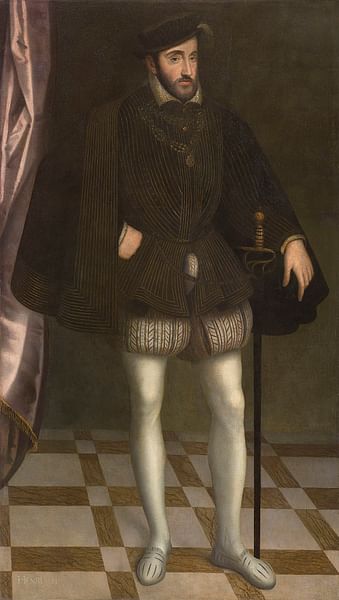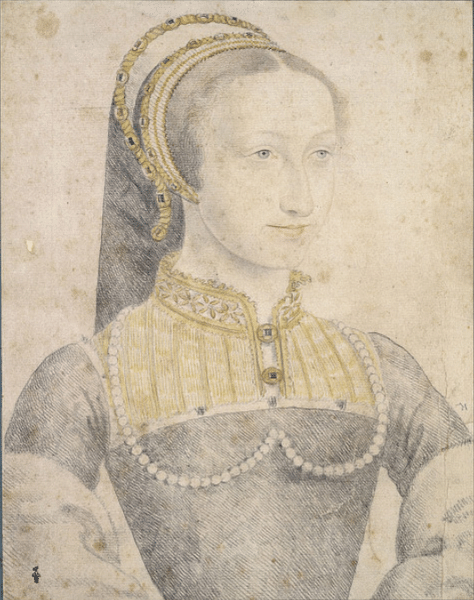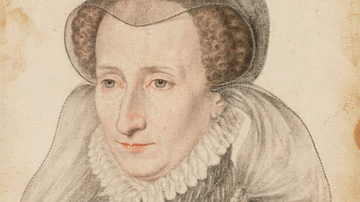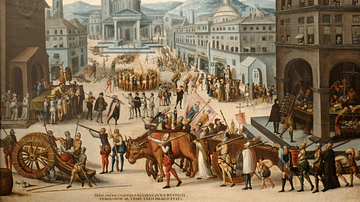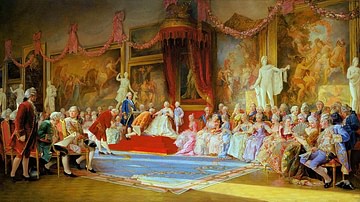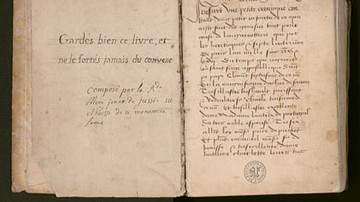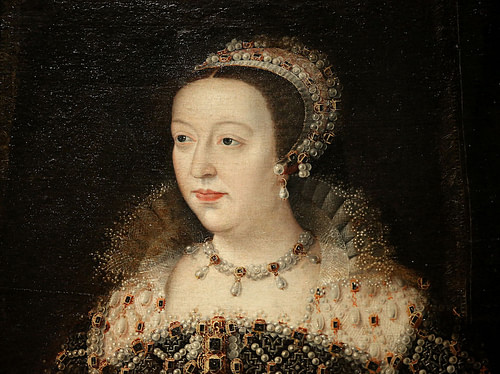
Catherine de' Medici (l. 1519-1589) was the queen of France, mother of three kings and two queens and, between 1559 and c. 1576, the most powerful woman in France and, possibly, all of Europe. She was the strength behind the French throne for almost 20 years, maintaining the monarchy through the chaos of the French Wars of Religion and political intrigue.
Her parents died shortly after her birth, and the first ten years of her marriage to King Henry II of France (r. 1547-1559) were difficult owing to her seeming infertility and her husband's obvious preference for his mistress, Diane de Poitiers (l. 1500-1566). In 1544, she gave birth to her first son, Francis II of France (aka François II, r. 1559-1560) and would have ten children in all, including Elisabeth of Valois, Queen of Spain (l. 1545-1568), Charles IX of France (r. 1560-1574), Henry III of France (r. 1574-1589), Margaret of Valois, Queen of France (l. 1553-1615), Claude of France, Duchess of Lorraine (l. 1547-1575), and Francis, Duke of Anjou (l. 1555-1584).
When her husband died in 1559, Catherine was finally able to assert control over her life through her sons. She raised Mary, Queen of Scots (l. 1542-1587) at the French court and arranged the marriage between Mary and her son Francis II with Mary's mother, Mary of Guise (l. 1515-1560). As regent, she carefully negotiated with the powerful Guise family, notably the brothers Francis, Duke of Guise (l. 1519-1563) and Charles, Cardinal of Lorraine (l. 1524-1574), who sought to rule through her son.
Throughout the French Wars of Religion (1562-1598), she did her best to maintain order in the midst of the social unrest and violence caused by the Protestant Reformation and, at first, tried to reconcile the opposing factions – even arranging the marriage of her Catholic daughter Margaret to the Protestant prince Henry of Navarre (later King Henry IV of France, l. 1553-1610) in hopes of peace – but failed dramatically when she supported the St. Bartholomew's Day Massacre in August 1572.
Her legacy continues to be debated as she is often characterized as either the scheming 'black queen' whose policies epitomized the political means and ends of Machiavelli and who immersed herself in the occultism of the time or as a noble monarch who did the best she could for France during one of its darkest periods.
Early Life & Marriage
Catherine was born on 13 April 1519 in Florence (modern Italy) to Lorenzo de' Medici, Duke of Urbino (l. 1492-1519, not the famous Lorenzo de' Medici known as "The Magnificent") and Madeleine de La Tour d'Auvergne (l. 1498-1519), a relative of Francis I of France (r. 1515-1547). Catherine's parents are said to have been elated at her birth and welcomed their daughter warmly, but both died within a month, her father from syphilis and her mother from either the same or from the plague. Catherine was taken in by her paternal grandmother, who died shortly afterwards, and was then cared for by her aunt, Clarice de' Medici. When her relative Giulio de' Medici was elected pope and became Pope Clement VII in 1523, he had Catherine installed in the Palazzo Medici Riccardi, the palace of the wealthy Medici family who had prospered as bankers.
The wealth of the Medici family allowed them access to political power in Florence, but they were not regarded as equals by the aristocracy. In 1527, they were ousted, and Catherine spent three years living in convents, her life threatened at times because of her family name, until Clement VII called her to Rome in 1530 to arrange her marriage. Francis I of France offered his son, Henry, in 1533, and Clement VII saw this as an opportunity for a Medici to rise to aristocracy, and so he accepted. The couple was married in October of the same year.
Although he played the part of the groom expected of him at the wedding and the wedding night, Henry had no interest in Catherine and spent most nights with his mistresses and, eventually (or right from the start, according to some sources), with Diane de Poitiers. Diane was everything Catherine was not: she was supremely self-confident, beautiful, an aristocrat, whose parents had encouraged her athletic interests and education in a wide array of subjects including architecture and the law. She was also independently wealthy since, after the death of her husband, she had made use of her legal skills to retain his estate without the requirement of a male consort-supervisor.
Catherine was queen in name only. She had no political power and no influence over the king or the court. She was distrusted by the courtiers as a foreigner and shunned as a commoner. Further complicating her position, she seemed unable to conceive a child. In 1536, Henry's older brother Francis died of fever, and Henry became heir to the throne. It was now more important than before that Catherine give Henry a child, and so she took to folk remedies to increase fertility such as placing cow dung on her vagina and drinking animal urine. She consulted astrologers and folk healers and, later, the physician and seer Nostradamus (l. 1503-1566), who she elevated to the position of chief physician for Charles IX.
Her association with astrology – which the Church condemned – as well as with folk remedies, Nostradamus, and others like him is the source of the later claim that she was involved in occult practices. At the same time, however, she was also suspected of being a witch because of her inability to conceive. The proper function of a woman was understood to be childbearing, and those who could not conceive were apt to raise suspicions of witchery because witches were understood to be in league with the devil, who could not generate life, and so were infertile. Catherine was never charged with witchcraft, but there were suggestions by the nobility that the king should divorce her.
Henry, meanwhile, was spending his nights with Diane. Diane had been a lady-in-waiting to Queen Claude of France, Henry's mother, who died when he was young, and she seems to have been seen as a mother figure by him at an early age. As his lover, she was the most powerful woman in France, but she encouraged his relationship with Catherine and, especially, that he spend more time in Catherine's bedchamber than her own to produce an heir to the throne. Catherine gave birth to her first son, Francis II, in 1544 and, afterwards, found no difficulty in conceiving further, eventually giving birth to ten children, seven of whom lived to adulthood or young adulthood.
Queen Catherine & The Guise
In 1559, as part of the treaty ending the conflict between France and the Holy Roman Empire, Henry II had his daughter Elisabeth of Valois married to King Philip II of Spain. The marriage celebration included jousting tournaments, a sport Henry II was especially skilled in and proud of. When he was unseated by his opponent, Gabriel, Comte de Montgomery, he called for a rematch during which Montgomery's lance shattered against Henry II’s helmet, sending shards of wood into his eye and forehead. The wood penetrated into his brain, and he lived a little over two weeks before succumbing to the injury, dying on 10 July. Throughout this time, Catherine remained by his side, and although he called for Diane de Poitiers, she denied her entrance to the chamber. After Henry's death, Catherine dressed in black – as was the custom for widows who could wear either white or black – and took the broken lance as her symbol.
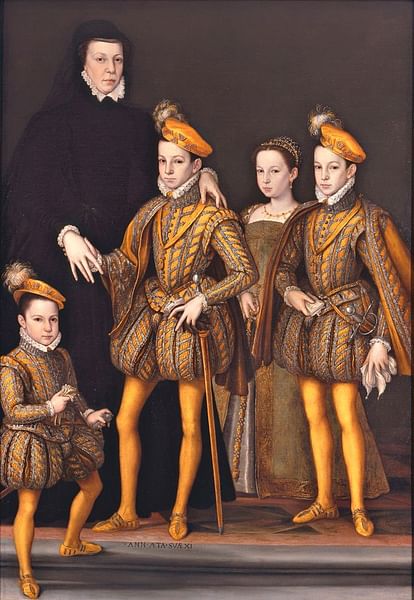
Francis II was crowned king at the age of 15 and could legally rule on his own but bowed to his mother's authority and issued decrees jointly in her name. As soon as she was able, Catherine evicted Diane de Poitiers from the Château de Chenonceau and took back from her the crown jewels.
She established herself as the power behind Francis II, but the Guise brothers had their own agenda and quickly isolated Francis II from the crown's most trusted advisors including Louis de Bourbon, Prince of Condé (l. 1530-1569) and the powerful Gaspard II de Coligny, Admiral of France (l. 1519-1572). Catherine recognized the threat the Guise posed and diplomatically invited them to instruct and counsel her son, moving herself further into the background but still maintaining her influence over the king.
Amboise Conspiracy & War
Louis de Bourbon and Admiral Coligny had both declared for the Protestant cause, while Catherine and the Guise brothers were devout Catholics. Tensions between the Protestant Calvinist sect and Catholics had increased since 1534 and became more pronounced after the death of Henry II and the Catholic faction's move to control Francis II through the Guise brothers. In 1560, a group of Protestants, including Louis de Bourbon, planned to kidnap Francis II to rescue him from the Guise's influence, but the plot (known as the Amboise conspiracy) was discovered, and the participants jailed or executed.
Jeanne d'Albret (l. 1528-1572), Queen of Navarre, had outlawed Catholicism in her kingdom that same year, publicly declaring for Calvinism, and Catherine responded, in part, by appointing d'Albret's Catholic husband, Antoine de Bourbon (l. 1518-1562, brother of Louis de Bourbon), Lieutenant-General of France. This act is thought by some scholars to have been intended to drive a wedge between Antoine and his Protestant wife by making Antoine responsible for suppressing Protestant heresy. Tensions throughout the country continued until 1562 when Francis, Duke of Guise, slaughtered members of a Protestant congregation in the Massacre of Vassy and set off the French Wars of Religion.
Francis II had died in 1560 from an ear infection, and Charles IX became king at the age of nine. The Bourbon family had a claim to the throne if the Valois were unable to provide a king of mature age, and so Antoine de Bourbon should have now assumed the role of regent to Charles IX, but his brother had been arrested after the Amboise conspiracy and slated for execution. Catherine traded the life of Louis de Bourbon for Antoine's renunciation of his claim as regent and so was able to maintain her position. The move was ultimately irrelevant as Antoine was killed in battle in 1562.
Francis, Duke of Guise, was assassinated in 1563, loosening the hold the Guise had on the throne, and Catherine was quick to assert more control over Charles IX. In 1564-1565, in an effort to reaffirm the authority of the crown, Catherine accompanied her son on a grand tour through France to show the people that their king was responsive to their needs. At this point, she was interested in reconciling Protestants and Catholics and met with Jeanne d'Albret to reach some sort of compromise. When these efforts failed, she had Charles IX contact representatives of the Ottoman Empire with a plan to relocate Protestant French to Ottoman Moldavia, but there was no incentive given, and the Ottomans rejected the proposal.
In 1567, Charles IX was ambushed by Protestant forces in the Surprise of Meaux, which he and Catherine barely escaped, and she then abandoned hopes of reconciliation and, according to some scholars, began formulating a plan to execute the leading Protestants. This claim has been challenged, although there is evidence that Catholic nobles had suggested such a plan as early as 1560, or earlier, and it seems likely that Catherine would have been aware of it, even if she did not conceive of it herself. Louis de Bourbon, one of the most powerful Protestant leaders, had been executed after surrendering in 1569, Jeanne d'Albret was untouchable in her stronghold of La Rochelle or her Kingdom of Navarre, and so the most accessible target for assassination was Admiral Coligny.
St. Bartholomew's Day Massacre
Although it has been suggested that Catherine proposed to d'Albret the marriage of her daughter Margaret to d'Albret's son Henry as part of an intricate plot to lure the leading Protestants to Paris for execution, there is no evidence to support this claim. The wedding was set for 18 August of that year and drew Protestants from all over the country to Catholic Paris. Jeanne d'Albret arrived early and fell ill after shopping for the wedding one day, dying, probably of tuberculosis, on or around 9 June 1572. Rumors spread that she had been poisoned by Catherine through a pair of gloves, but there is no evidence for this. The Protestant leaders, including Admiral Coligny, were all housed in a specific area of Paris, and three days after the wedding, an assassination attempt was made on Coligny as he returned to his apartment. He was wounded in his hand and arm by gunshot and was carried to his chambers. The would-be assassin was never identified.
The Protestants suspected the crown of complicity in the assassination attempt, and Charles IX and Catherine, fearing they would attack, ordered a preemptive strike, which would become known as the St. Bartholomew's Day Massacre. On the night of 23 August, it was decided that the Protestant leaders should be eliminated, and the massacre began the next morning with the murder of Coligny who was killed in his apartment, thrown out the window, and decapitated. The other leaders were quickly slaughtered, and although Charles IX then called for restraint and an end to the violence, the common people took to the streets, hunting down Protestants and Protestant sympathizers and killing them.
News of the massacre spread, and more Protestants were murdered in other cities and towns throughout France resulting in a death toll in the thousands, with a low count at around 5,000 but more likely over 25,000 killed or more. The exact number is difficult to ascertain as many corpses were thrown into the Seine in Paris, and there is no way to know precisely how many were killed elsewhere.
Henry's Reign & Death
France was now divided between a Catholic north and Protestant south. Henry of Navarre had managed to escape execution in the massacre by promising to convert to Catholicism and then took command of Protestant forces with Henry I de Bourbon (l. 1552-1588, son of Louis de Bourbon) against the Catholic League headed by Henry I, Duke of Guise (l. 1550-1588, son of Francis, Duke of Guise). Catherine's son Henry III had left the country to reign in Poland-Lithuania, and Catherine was working with the Guise and Charles IX to find a way to restore peace when Charles IX died in 1574. Catherine wrote to Henry III, who returned to France to claim the throne.
Catherine's youngest son, Francis, Duke of Anjou and Alencon, sided with the Protestants as the French Wars of Religion continued, and then, after another of the many peace treaties had been signed, he left for the Netherlands where his troops were massacred, and he returned to France to be upbraided and scorned by his mother, dying in 1584. Henry III, meanwhile, was struggling to maintain his authority against the intrigues of Henry I, Duke of Guise, who had turned Paris against him, claiming he was a Protestant sympathizer. Although Henry III at first took counsel from his mother, he had gone his own way before the so-called War of the Three Henrys (1585-1589) between Henry III, Henry, Duke of Guise, and Henry of Navarre.
In September 1588, Henry III invited the Guise to a meeting at Blois where he had Henry of Guise and his uncle, the cardinal, assassinated and then eliminated others of the family. Henry of Guise's younger brother took over the Catholic League and denounced Henry III who allied with Henry of Navarre against the Catholics. Catherine was devastated by her son's actions and, according to some sources, this upset contributed to her failing health. She died on 5 January 1589, most likely from pleurisy. Henry III was assassinated in 1589, naming Henry of Navarre as his successor. Henry of Navarre, realizing Paris would never accept a Protestant king, converted to Catholicism, took the name Henry IV, and concluded the French Wars of Religion in 1598 through the Edict of Nantes.
Conclusion
Catherine's association with the St. Bartholomew's Day Massacre has largely defined her legacy and given rise to the claim that she was a Machiavellian queen, engaged in constant scheming and intrigue, which the massacre is only the most notable example of. Actually, though, her 'intrigues' were no more nefarious than any other monarch of the time and were more or less thrust upon her by circumstances as she did her best to manage in the interests of her sons, herself, and of France.
Although her personal accomplishments and education were ignored by her husband, Catherine was as able an architect and intellectual as Diane de Poitiers, dramatically enlarging and improving the Château de Chenonceau and other structures. She was an active patroness of the arts, in keeping with the practice of her family in Italy, and lavished large sums on theatrical productions, monuments, and paintings.
For most of the first 40 years of her life, Catherine de' Medici found her life directed by others, and once she was able to establish her own place and personal power, she fought to maintain it. Although this description of her life may not be as intriguing as 'occultist' or 'Machiavellian schemer', it would seem to be more accurate and fitting better one of the greatest queens of France.
